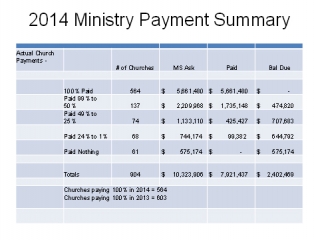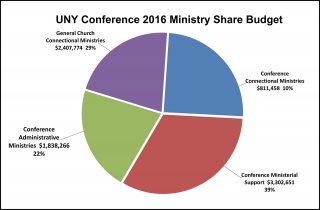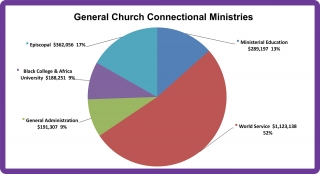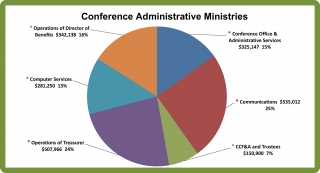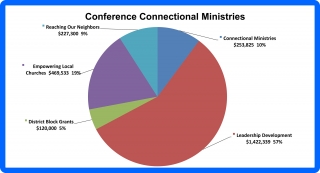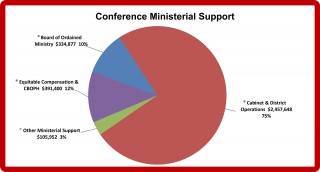events
2015 Annual Conference FAQs
*Please check back frequently, as more questions and answers are added daily.
2016 Shared Ministries Budget
Clergy Support
Trustees
Circle Conversations
Other Resolutions/Petitions
Misc. Questions
2016 Shared Ministries Budget
Could we utilize our annual statistical reports and data to provide a conference-wide picture of spending at the local church level in such areas as fixed costs, staff, utilities, property maintenance, ministry outreach and ministry shares? Yes, we have started to use our statistical information to better understand how churches are prioritizing their financial resources. We have been working to improve the timeliness and accuracy of the data being reported.
Please share more detail of our 904 churches' 2014 Ministry Share payments.
(Click on the image below to make it larger.)
Has the Reaching Our Neighbors Ministry Oversight Team budget been affected by classifying grants as contingent 2016 expenditures? The Reaching Our Neighbors MOT budget was not directly affected by the reclassification of grants to the contingent category, however, approximately $170,000 of grants were reclassified to contingent in the other MOTs and the Campus Ministry budgets.
What is being done with the our churches to increase Ministry Share giving to 100% and what are the ramifications for churches not paying 100% of their Ministry Shares? Several initiatives have been put in place over the past several months to encourage and track Ministry Share payment levels with the objective of increasing giving. Our Conference Council on Finance & Administration, District Superintendents and Conference staff regularly review the status of payments and develop strategies to address arrearages. These strategies include billing notices sent to Pastors, articles and brochures promoting Ministry Share giving, as well as, individual and group meetings with church representatives. Ongoing plans include expanding discussion at individual churches by local laity and Conference staff to address challenges, solutions and plans specific to improve that particular church's giving. Consequences for not paying Ministry Shares vary depending on each specific situation including increased scrutiny, correspondence and discussion by the District Superintendent and Conference staff with the church leadership.
How can our Laity better explain why Ministry Shares are so important? Great question. The enthusiasm and support of our Lay members is a fundamental part of the success of the Methodist Church. Explanations of our Ministry process and uses may be found at http://www.unyumc.org/about/ministry-shares on the Conference website.
How are Conference staff salaries determined? The Conference process to set pay levels follows best business practices starting with our Benefits Office setting the main parameters of a staff position including job responsibilities, salary survey data, experience levels, education requirements and job descriptions. Annual pay increases are tied to the annual clergy pay rate increase which is .8% for 2016 except for the Conference senior staff which will not have a pay increase in 2016.
How can we say that we are prioritizing ministry when we pay staff over $100k per year and the base compensation for Pastors is only 40% of that? Several thoughts come to mind:
- Conference staff are engaged in their ministries to do the Conference level work of our Church. While this work may seem to be less mission driven than the work done at our local churches, it is no less important to the overall support and success of our United Methodist mission to “live the Gospel of Jesus Christ and to be God’s love with our neighbors in all places."
- The base clergy pay level is a starting pay level that is increased for years of service and other factors.
- Clergy receives a housing allowance or parsonage in addition to their pay.
- Every reasonable effort is made to attract competent, dedicated staff to serve in the various Conference jobs. The Conference competes in the same market for staff as other businesses in Central New York.
Please share a 'pie chart' of the 2016 Ministry Share budget.
(Click on the images below to make them larger.)
Please note: The color border corresponds to the pie pieces.
Clergy Support
Would the uniformity of having Moving Coordinators balance the cost of hiring for new employment positions (assuming that the Moving Coordinator is not just added to someone’s present job description)? The Conference Moving Coordinator and the District Moving Coordinators are volunteer positions.
Under current policies, I am unable to serve ¾ time and receive health insurance. I would like the option to pay the additional cost of the coverage that I might have the necessary coverage now and after retirement. This restriction has implications of ministry for many of us. I am unable to discern the missional aspects of our current policy structure regarding this issue. Thank you for your consideration. The mandatory risk pool rules of HealthFlex require us to include ALL clergy in the eligible categories in our plan. Therefore, if ¾ time clergy were eligible, ALL ¾ time clergy would be in the plan. There are clergy who have requested ¾ time appointments because they DON’T want to be in the plan. In the insurance industry, underwriters use risk pools to establish premium rates. Premium rates, as a result, can be adversely affected when the risk pool incudes part time persons. This is not in our control and when serving such a diverse group of people, we feel challenged to meet the needs of all.
What are we doing to reduce the cost of clergy healthcare (I know I can get comparable coverage for less money)? The answer to this simple question is actually very complex. The Conference Board of Pension & Health Benefits reviews and discussed the health care program at every meeting. We have consistently sought bids to lower the cost and are confident that we have secured the lowest cost GROUP rates available. The introduction of the state health exchange has changed people’s perception of the cost of health insurance. Some people can get lower cost insurance. However, did you know that your church cannot pay for it? It is against federal regulations for an employer to pay for insurance on the state exchange. The Board is exploring whether it can mandate higher salaries for clergy so that they can purchase health insurance from the exchange. There have been some recent legal challenges to that option, so we are waiting for federal guidelines. In the meantime, if that were to be done, the higher salary paid to clergy would be fully taxable, including self-employment tax. So a clergyperson would pay about $300 in taxes for every $1,000 provided in salary for the purchase of health insurance. Our non-taxed premium is $1,000 per month, so we still believe it is a good value overall.
Trustees
In local church discontinuation resolutions, the church to be discontinued is described as one which “no longer serves the purpose for which it was organized.” Given how difficult and often painful it is for a church to discontinue, could we use other language? These words seem to go against Wesley’s rule “to do no harm.” The resolution to discontinue is a legal document designed to satisfy the requirements of New York State law as well as church law. The phrase “no longer serves the purpose for which it was organized” is a legal term, recognizing the reality that organizations have a life-cycle. As they age, there comes a time when they are no longer able to fulfill the purpose for which they were organized. As such, the phrase “no longer serves the purpose for which it was organized” is meant to be descriptive, not judgmental. It means the church in question has reached the point in its life-cycle where it can no longer continue to carry out the mission of a local church: to make disciple of Jesus Christ for the transformation of the world. This phrase in no way questions the past fruitfulness of the church or the future fruitfulness of its members as they transfer their membership to other congregations.
Circle Conversations
Will sharing around the circles be non-rebuttal with only one person speaking at a time (with no back and forth)? In order to provide each circle group participant the opportunity to speak and be heard by others, only one person will speak at a time. While they are sharing their reflections on the particular question at hand, others will be asked to listen attentively. To help focus both speaker and listeners, the speaker will hold a “taking piece” in their hands, signifying to right of the speaker to share and the obligation of the listeners to listen. After all have had the opportunity to share and at the direction of the of the facilitator, groups might engage in respectful conversation around what has been shared. This would be a time to clarify what has been heard, not rebut or debate particular positions.
Will the questions to be asked during the Circle Conversations be shared in advance? At the present time the intent is to share the discussion questions for the first time during the actual conversations at conference. The reason to hold off until that time is these questions were written to stimulate sharing in the circle group. The questions don’t require prior research or forethought to be answered.
Will voting on the resolutions be done by secret ballot or with a show of hands? Voting will be done by paper ballot, not show of hands. Each individual voter will receive a paper ballot on which all 8 petitions will be listed with the option to “adopt” or “not adopt” provide for each petition.
If this circle conversation process is voted down, how do we deal with these 8 human sexuality related petitions/resolutions? If the process to vote on these petitions/resolutions without debate or amendment is not adopted by the conference, these petitions/resolutions will be deliberated according to the same rules adopted for all other petitions/resolutions, i.e., floor debate, provision for amendment, referral, tabling and voting to adopt or not adopt.
Will we pray before the circle conversations? We will pray multiple times during this process, inviting God to bless us in our speaking and listening.
Other Resolutions/Petitions
GBPHB offers viewpoint on petitions that could affect benefit plan administration
Several annual conference sessions will be considering petitions that if adopted would impact the way the General Board of Pension and Health Benefits (GBPHB) fulfills its responsibility to supervise and administer sustainable benefit plans for more than 74,000 clergy and lay employees of The United Methodist Church. GBPHB has drafted two documents to express its position in relation to these petitions: “Addressing Human Rights – Israel and the Palestinian Territories” and “Promoting Financial and Environmental Stewardship.” Click on the links to access PDF versions of the documents.
Misc. Questions
Have the negative parts (dilemmas) identified in the FACT report been addressed or is there a plan for addressing them? The FACT report identified five areas of concern: leadership, finances, trust, communications and United Methodist ethos. To address the concerns addressed in each of these areas, a team for each area was organized in January to work on ways to implement recommended solutions. Some of this work has been accomplished and more is planned. These teams are expected to complete their work the end of June. A status report is expected to be made to the conference sometime this summer.
If I don’t want to read the preconference materials on line, what are my options? Why doesn’t the conference just buy every person a hardcopy of the preconference workbook? The preconference workbook is available for download in pdf format without cost. If individuals would like a bound paperback version, they can purchase this from lulu.com for $9.47 plus tax and shipping. This provides conference members with various format options, recognizing some like a hardcopy while others prefer to a digital copy. It also represents good stewardship of conference resources, keeping the conference from purchasing unneeded and/or unused materials.
Is there a list of clergy eligible to be elected to General and Jurisdictional Conferences that will be given out at conference? A list of all eligible clergy, including but not limited to those who’ve identified themselves as candidates, will be included in the packet of information received at registration. This list will not include those clergy who have asked that their names be removed from consideration.
